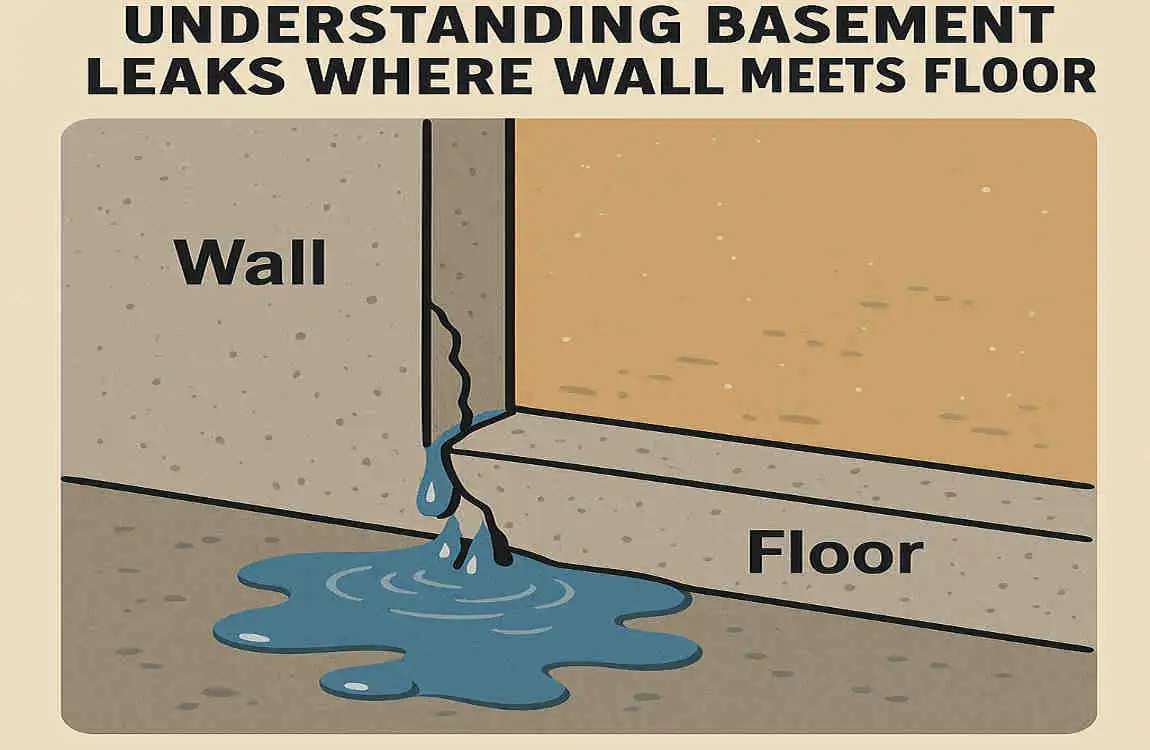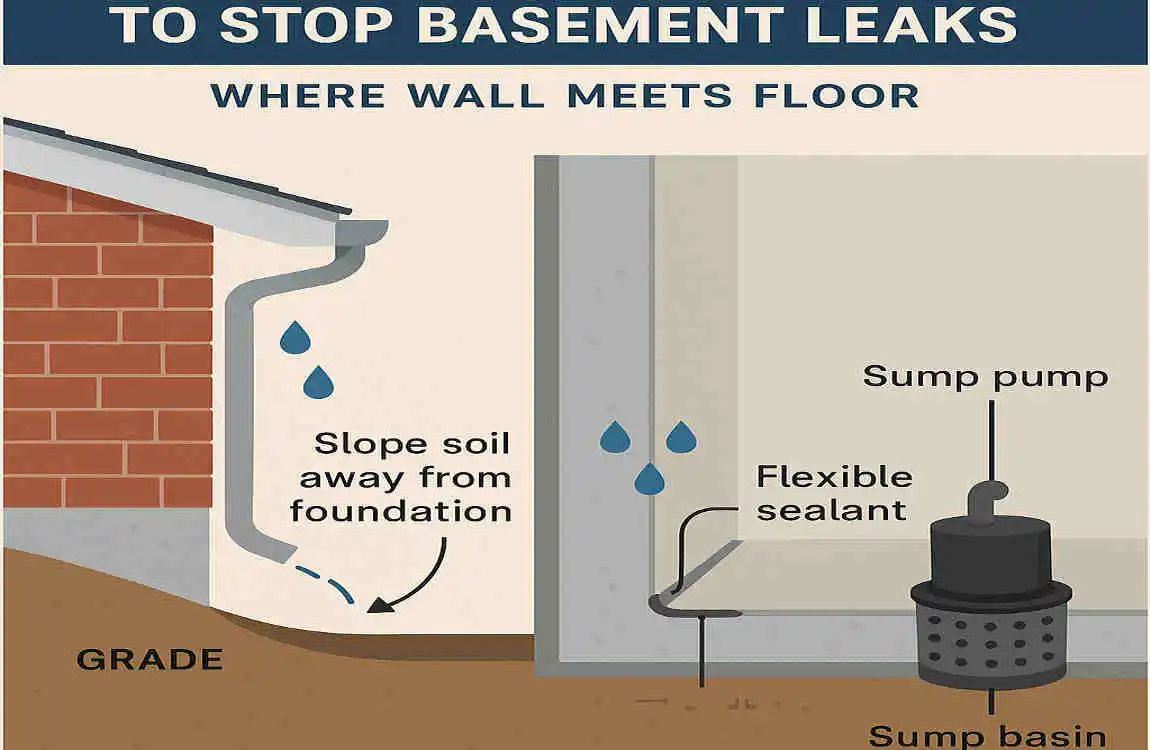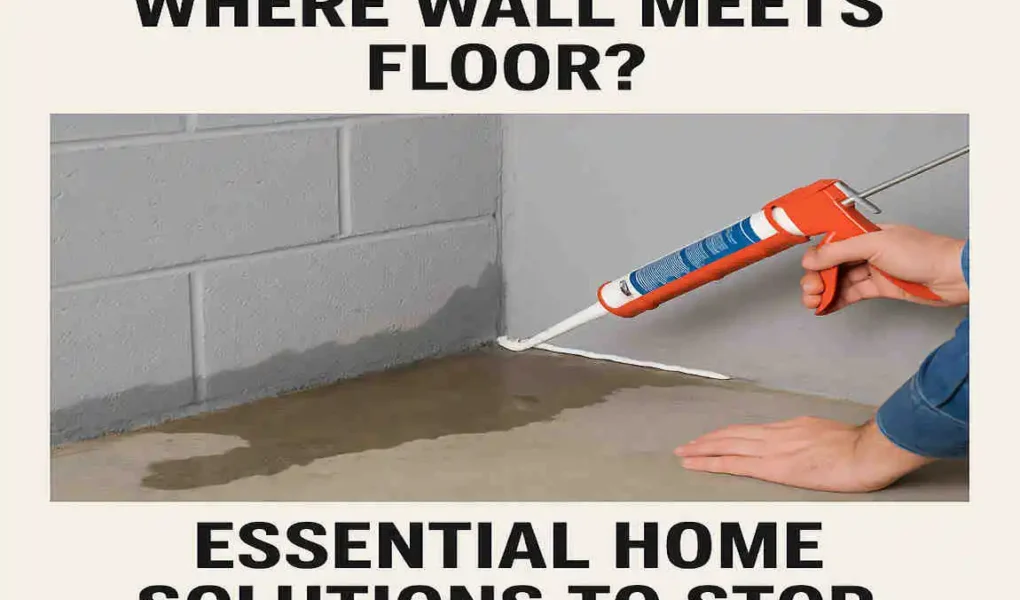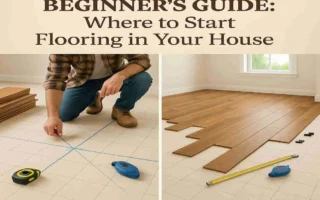Basement water leaks are a common concern for many homeowners, especially when the water seeps in where the wall meets the floor. This vulnerable area, known as the cove joint, can lead to significant water damage, mold growth, and even structural issues if left unaddressed.
Understanding Basement Leaks Where Wall Meets Floor

The junction where your basement wall meets the floor is often called the cove joint. This area is particularly prone to leaks because it’s a natural point of weakness in your basement’s construction.
When water accumulates around your home’s foundation, pressure builds, and it seeps into the basement through this joint. Let’s break down the common causes of leaks at this critical point.
Common Causes of Leaks at the Cove Joint
Hydrostatic Pressure
This is the pressure exerted by water in the soil surrounding your foundation. When the water table rises due to heavy rainfall or poor drainage, it pushes water through the smallest gaps or cracks, especially at the cove joint.
Damaged Waterproofing
Over time, the waterproofing layers on your home’s foundation can deteriorate. Whether it’s exterior waterproofing membranes or interior coatings, any damage can allow water to seep in.
Foundation Cracks
Small cracks in your basement walls or floor can worsen over time, creating easy pathways for water to enter.
Clogged or Failed Drainage Systems
Systems like weeping tiles, French drains, or even your gutters and downspouts can fail if they’re clogged or improperly installed, leading to water pooling around your foundation.
Plumbing Leaks
Sometimes, the issue isn’t external. A leaking pipe can increase moisture levels in your basement and exacerbate existing leaks.
Why Homeowner’s Insurance May Not Cover These Leaks
It’s worth noting that most homeowner’s insurance policies don’t cover basement leaks caused by maintenance issues. These leaks are preventable with proper maintenance, so it’s crucial to stay proactive to avoid costly repairs.
Signs and Risks of Basement Leaks at the Cove Joint
Identifying a basement leak early can save you time, money, and stress. Pay attention to these common signs of water intrusion:
Signs of a Basement Leak
- Visible Water Seepage: Look for water pooling along the edges of your basement floor.
- Damp or Wet Walls: Discoloration or damp spots on the walls near the floor are red flags.
- Mold Growth: Mold thrives in damp environments. If you notice black or greenish patches, it’s a sign of moisture problems.
- Musty Odors: A persistent musty smell indicates excess moisture and poor ventilation.
- Efflorescence: This white, powdery substance on walls or floors is caused by water evaporating and leaving behind mineral deposits.
Risks of Ignoring Basement Leaks
Failing to address leaks at the cove joint can lead to a host of issues, including:
Foundation Damage
Over time, water can weaken your home’s foundation, leading to cracks and structural instability.
Interior Damage
Water can ruin flooring, drywall, furniture, and personal belongings stored in your basement.
Mold and Health Hazards
Mold spores can spread quickly, posing health risks like allergies and respiratory issues.
Expensive Repairs
What starts as a small leak can escalate into extensive and costly repairs if not addressed promptly.
Essential Home Solutions to Stop Basement Leaks Where the Wall Meets the Floor

Now that we understand the causes and risks, let’s explore the most effective solutions to stop and prevent basement leaks.
Exterior Solutions
Proper Grading and Landscaping
Ensure the ground slopes away from your home’s foundation to prevent water from pooling. A slope of at least 6 inches over a 10-foot span is ideal.
Gutters and Downspouts
Clean your gutters regularly to prevent blockages. Extend downspouts at least 4–6 feet from the foundation to direct water away from the foundation.
Foundation Drainage Systems
Install systems like French drains or weeping tiles to channel water away from your foundation.
Waterproofing Membranes
Apply an exterior waterproofing membrane to your foundation walls to create a barrier against water intrusion.
Interior Solutions
Waterproof Coatings and Vapor Barriers
Apply waterproof paint or coatings to your basement walls and floors. Vapor barriers can also help block moisture from seeping in.
Repairing Foundation Cracks
Use epoxy or polyurethane injections to seal cracks and prevent water infiltration.
Interior Drainage Systems
Install a sump pump and interior drainage system to manage water entering your basement. Sump pumps are especially effective in areas prone to heavy rainfall.
Routine Maintenance Tips
- Inspect Gutters and Drains: Regularly check for clogs or damage.
- Fix Plumbing Leaks: Address any leaks promptly to reduce moisture levels in your basement.
- Monitor Humidity: Use a dehumidifier to keep humidity levels below 60%.
When to Call a Professional
While some solutions can be DIY, there are situations where professional help is essential.
When DIY Isn’t Enough
- Persistent or worsening leaks despite your efforts.
- Visible foundation cracks that require extensive repair.
- Significant water pooling around your foundation.
Benefits of Professional Services
- Expert Assessment: Professionals can identify the root cause of the leak and recommend tailored solutions.
- Advanced Techniques: From advanced waterproofing systems to structural repairs, professionals have the tools and expertise to handle complex issues.
- Peace of Mind: Hiring a professional ensures the problem is fixed correctly the first time correctly, saving you money in the long run.




